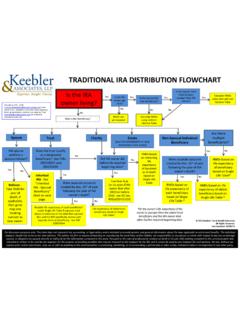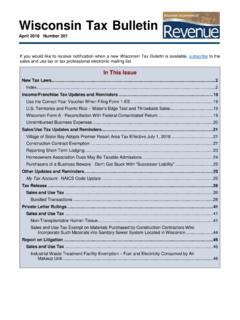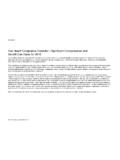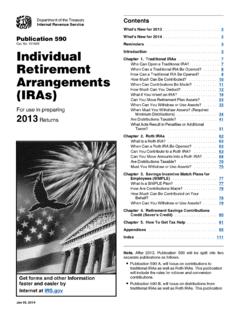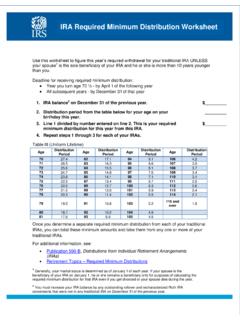Transcription of For discussion purposes only. This chart does not ...
1 2012 Keebler Tax & Wealth Education All Rights Reserved For discussion purposes only. This chart does not represent tax, accounting, or legal advice. It is meant only to provide guidelines on generic situations. The individual taxpayer is advised to and should rely on their own advisors. This work is for discussion purposes only and intended to provide general information about the laws applicable to retirement benefits. The author, his firm or anyone forwarding or reproducing this work shall have neither liability nor responsibility to any person or entity with respect to any loss or damage caused, or alleged to be caused, directly or indirectly by the information contained in this work.
2 This work does not represent tax, accounting, or legal advice. Not for use or distribution to the general public. REQUIRED MINIMUM DISTRIBUTIONS (RMDs) UPON THE DEATH OF A BENEFICIARY UNDER IRC 401(a)(9) Beneficiary Original IRA Owner Died Prior to Required Beginning Date Original Owner Died On or After Required Beginning Date Spouse - Inherited IRA (No rollover) (1) If the surviving spouse dies prior to the end of the year in which the owner would have been age 70 1/2, the surviving spouse is deemed to be the owner/participant and a beneficiary is determined as of September 30th of the year following the year of the surviving spouse's death.
3 The RMDs will then be based on such surviving spouse's beneficiary's life expectancy under the 401(a)(9) rules. See Examples 1 and 2. (2) If the surviving spouse dies on or after the end of the year in which the owner would have reached age 70 1/2, an RMD for the current year must be taken if not taken by the surviving spouse during his/her life. Thereafter, RMDs are calculated based upon the now deceased surviving spouse's life expectancy by reference to his or her attained age in the year of death by reference to the Single Life Table. The initial factor is then reduced by one for each subsequent year that has elapsed ( "minus one method").
4 See Examples 3 and 4. During the life of the spouse, the applicable distribution period is the longer of: (1) the surviving spouse s life expectancy based on the Single Life Table using the surviving spouse s attained age in each distribution calendar year after the calendar year of the employee's death up through the calendar year of the spouse s death; or (2) the life expectancy of the deceased spouse under the Single Life Table using the age of the deceased spouse as of his or her birthday in the year of death, whereby in subsequent years, this factor is reduced by one for each passing year. At the death of the surviving spouse, the RMD for the year of death must be withdrawn for the year of death (if not already taken by the surviving spouse during his or her lifetime).
5 For subsequent years, the RMD factor is fixed based upon the method employed above. If surviving spouse's life expectancy is being used, his or her life expectancy is now fixed based upon the age of the surviving spouse in the year of death by reference to the Single Life Table using the minus one method. See Example 5. Spouse - Rollover Because the surviving spouse is the owner/participant, RMDs will be based (under the 401(a)(9) rules) on the surviving spouse's beneficiary's life expectancy as of September 30th of the year following the year of the surviving spouse's death. See Examples 6-8. Because the surviving spouse is the owner/participant, RMDs will be based (under the 401(a)(9) rules) on the surviving spouse's beneficiary's life expectancy.
6 The spouse's beneficiary is determined as of September 30th of the year following the year of the surviving spouse's death. Non-Spouse Individual Beneficiary Continue using the same payout method utilized prior to death of beneficiary (using the minus one method). See Example 9. Continue using the same payout method utilized prior to death of beneficiary (using the minus one method). Accumulation Trust for the Benefit of Spouse Continue using the same payout method utilized prior to death of surviving spouse (using the minus one method). See Example 10. Continue using the same payout method utilized prior to death of surviving spouse (using the minus one method).
7 Conduit Trust for the Benefit of Spouse (Assuming Designated Beneficiary Status) (1) If the surviving spouse dies prior to the end of the year in which the owner would have been age 70 1/2, under PLR 200644022, the five year rule applies. In PLR 200644022, the IRS held that the surviving spouse was to be treated as the owner (because the trust was a conduit trust for her benefit) and did not have a designated beneficiary even though the trust for her benefit had contingent beneficiaries. See Example 11. (2) If the surviving spouse dies on or after the end of the year in which the owner would have reached age 70 1/2, an RMD for the current year must be taken.
8 Thereafter, RMDs are calculated based upon the now deceased surviving spouse's life expectancy by reference to his or her attained age in the year of death by reference to the Single Life Table using the minus one method. See Example 12. During the life of the surviving spouse, the applicable distribution period is the longer of: (1) the surviving spouse s life expectancy based on the Single Life Table using the surviving spouse s attained age in each distribution calendar year after the calendar year of the employee's death up through the calendar year of the surviving spouse s death; or (2) the life expectancy of the deceased spouse under the Single Life Table using the age of the deceased spouse as of his or her birthday in the year of death, whereby in subsequent years, this factor is reduced by one for each passing year.
9 At the death of the surviving spouse, the RMD for the year of death must be withdrawn for the year of death (if not already taken by the surviving spouse during his or her lifetime). For subsequent years, the RMD factor is fixed based upon the method employed above. If surviving spouse's life expectancy is being used, his or her life expectancy is now fixed based upon the age of the surviving spouse in the year of death by reference to the Single Life Table using the minus one method. See Example 13. Pursuant to the rules of professional conduct set forth in Circular 230, as promulgated by the United States Department of the Treasury, nothing contained in this communication was intended or written to be used by any taxpayer for the purpose of avoiding penalties that may be imposed on the taxpayer by the Internal Revenue Service, and it cannot be used by any taxpayer for such purpose.
10 No one, without our express prior written permission, may use or refer to any tax advice in this communication in promoting, marketing, or recommending a partnership or any other entity, investment plan or arrangement to any other party. 2012 Keebler Tax & Wealth Education All Rights Reserved For discussion purposes only. This chart does not represent tax, accounting, or legal advice. It is meant only to provide guidelines on generic situations. REQUIRED MINIMUM DISTRIBUTIONS (RMDs) UPON THE DEATH OF A BENEFICIARY UNDER IRC 401(a)(9) -EXAMPLES- Example 1 Alex died before his required beginning date and named his wife, Esmeralda, as beneficiary of his IRA.
